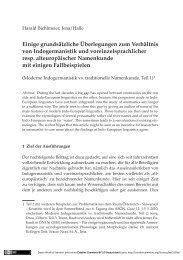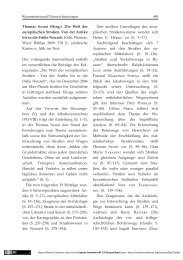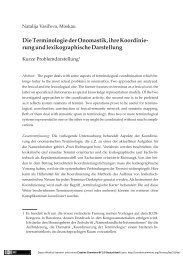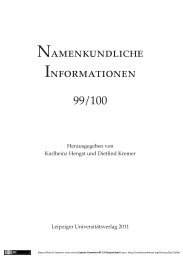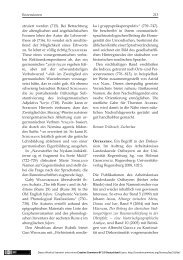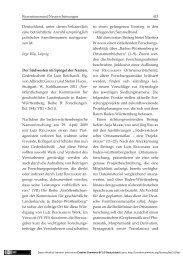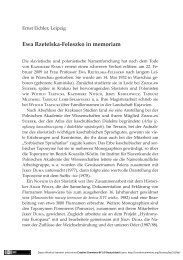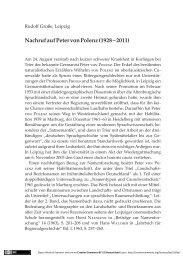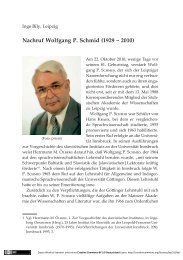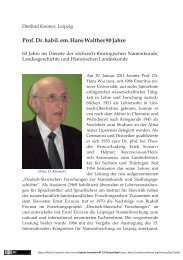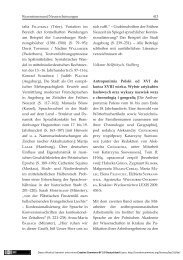Proper Names in the Light of Theoretical Onomastics
Proper Names in the Light of Theoretical Onomastics
Proper Names in the Light of Theoretical Onomastics
You also want an ePaper? Increase the reach of your titles
YUMPU automatically turns print PDFs into web optimized ePapers that Google loves.
<strong>Proper</strong> <strong>Names</strong> In <strong>the</strong> <strong>Light</strong> <strong>of</strong> <strong>Theoretical</strong> <strong>Onomastics</strong>137tomary for a person to have more than one Christian name which is why<strong>the</strong> full set is so numerous. On average, each person has two Christiannames. The relatively high frequency <strong>of</strong> Christian names <strong>in</strong> F<strong>in</strong>land canalso be attributed to <strong>the</strong> fact that, up to <strong>the</strong> 19 th century, <strong>the</strong>re were twoanthroponymic systems <strong>in</strong> F<strong>in</strong>nish. In eastern F<strong>in</strong>land, <strong>the</strong> b<strong>in</strong>ary nam<strong>in</strong>gsystem was used from about <strong>the</strong> 16 th century (a + B ) but <strong>in</strong> westernF<strong>in</strong>land, <strong>the</strong> village population was identified by <strong>the</strong> fa<strong>the</strong>r’s names whichcould be comb<strong>in</strong>ed with a byname identify<strong>in</strong>g <strong>the</strong> place where <strong>the</strong>y lived(Paikkala 1988, 27 ), a nam<strong>in</strong>g scheme A + (b). In ord<strong>in</strong>ary communication,<strong>in</strong> F<strong>in</strong>nish personal nam<strong>in</strong>g, <strong>the</strong> Christian name plays an important role.From <strong>the</strong> aspect <strong>of</strong> typology, a relatively similar use <strong>of</strong> anthrop<strong>of</strong>ormants<strong>in</strong> F<strong>in</strong>nish and Hungarian is characteristic. In F<strong>in</strong>nish, approximately 20 %<strong>of</strong> names are surnames with different anthrop<strong>of</strong>ormants.Statistical analysis <strong>of</strong> an extensive set <strong>of</strong> data will undoubtedly providemore precise <strong>in</strong>formation; however, it can be stated that, from <strong>the</strong> aspect<strong>of</strong> typology, <strong>in</strong> <strong>the</strong> comparison <strong>of</strong> l<strong>in</strong>guistic formation, e. g. surnames <strong>in</strong><strong>the</strong> b<strong>in</strong>ary nam<strong>in</strong>g system, a ratio between non-derived surnames (anthroponymicbases) and derived surnames (names with onymic formant)is characteristic. Research <strong>in</strong>to <strong>the</strong> use <strong>of</strong> language means <strong>in</strong> systems <strong>of</strong>(ma<strong>in</strong>ly) personal names has potential for <strong>the</strong> future.3. 5 Lexicography <strong>of</strong> proper namesHere we briefly outl<strong>in</strong>e <strong>the</strong> lexicographic procedures <strong>in</strong> a given onomasticonby which knowledge <strong>of</strong> a given onomastic object is objectivised: i. e.what <strong>in</strong>formation is added to an entry <strong>in</strong> order to “familiarise” a communicator(or a reader) with an onymic object, <strong>the</strong> structure <strong>of</strong> its l<strong>in</strong>gualnam<strong>in</strong>g or motivation and <strong>the</strong> history <strong>of</strong> its nam<strong>in</strong>g.With regard to <strong>the</strong> type and character <strong>of</strong> an onymic object, onomasticonsare classified <strong>the</strong>matically. Onomasticons can be fur<strong>the</strong>r dist<strong>in</strong>guished by<strong>the</strong> aim and scope <strong>of</strong> <strong>the</strong> onymy processed. Appropriate lexicographicprocedures are applied <strong>in</strong> respective dictionaries <strong>in</strong> respect <strong>of</strong> a given type<strong>of</strong> dictionary. In older onomasticons, <strong>the</strong> explanations focused ma<strong>in</strong>ly onelucidation <strong>of</strong> <strong>the</strong> etymology <strong>of</strong> a name. When <strong>the</strong> proprial componentsare considered as system phenomena and onymy as an <strong>in</strong>ternally-structuredwhole, <strong>the</strong>n <strong>the</strong> onymy processed <strong>in</strong> dictionaries is seen <strong>in</strong> a differentlight. Also, specific methodological procedures are used <strong>in</strong> which <strong>the</strong>pr<strong>in</strong>ciples <strong>of</strong> general onomastic <strong>the</strong>ory are realised.



